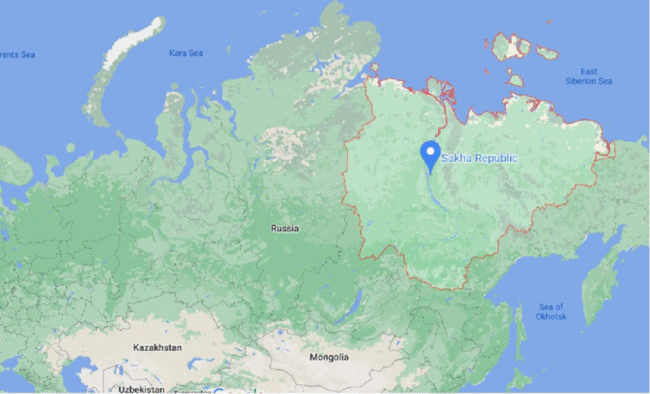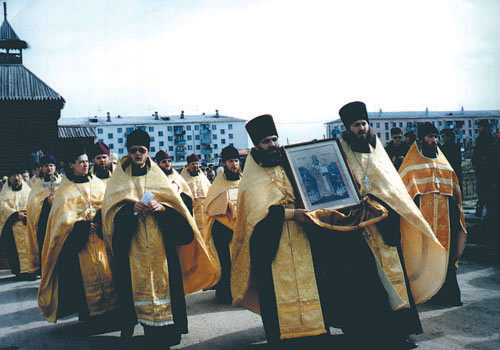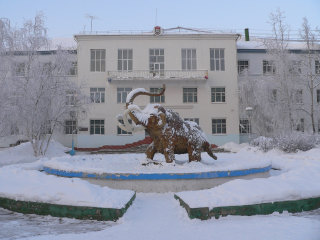Yakutsk: The Coldest Major City on Earth
Yakutsk is the capital and largest city of the Sakha Republic (Yakutia) in Russia. Located roughly 450 km (280 miles) south of the Arctic Circle, it has grown rapidly in recent years due to its mining industry, with a population of 355,443 as of the 2021 census.
Positioned in the Central Yakutian Lowland, Yakutsk lies on the Lena River and is a major port. It is served by Yakutsk Airport and the nearby Magan Airport.
🌡️ Climate and Weather Extremes
Yakutsk has a severely cold subarctic climate (Köppen: Dfc, bordering on Dfd), with:
- An average annual temperature of −8.0 °C (17.6 °F)
- Winter highs that rarely rise above −20 °C (−4 °F)
- A record low of −64.4 °C (−83.9 °F), recorded on February 5, 1891
This makes Yakutsk the coldest major city on Earth. Some smaller towns in the region, like Oymyakon, are slightly colder, but Yakutsk is by far the coldest large city.
It is also the largest city built on continuous permafrost—a condition where the ground remains frozen year-round. Because of this, many buildings are constructed on elevated concrete piles to prevent the heat from thawing the ground beneath them.

🧊 Seasonal Extremes
Yakutsk experiences some of the most extreme temperature swings on the planet:
- Coldest Month: January, with temperatures averaging −51.4 °C (−60.5 °F) (January 1900)
- Hottest Temperature: +38.4 °C (101.1 °F) on July 17, 2011
- Temperature range throughout the year exceeds 102 °C (184 °F)
Between November 10 and March 14, Yakutsk has never recorded a temperature above freezing. However, summers can be surprisingly warm, with daytime highs over +30 °C (86 °F) in July.
Interestingly, July in Yakutsk is hotter than in many southern coastal cities, such as Vladivostok or Yuzhno-Sakhalinsk, and even some subtropical regions. Yet, despite these warm summers, winters plunge to temperatures 35°C to 40°C colder than Scandinavian cities at similar latitudes.
🌍 Geographical Factors Behind the Cold
Several factors contribute to Yakutsk’s extreme climate:
- High latitude: Less sunlight and low sun angles in winter.
- Inland location: Nearly 1,000 km (620 miles) from the nearest ocean, meaning there’s no maritime influence to moderate temperatures.
- Permafrost: Keeps the ground frozen and cold, preventing heat storage.
- Siberian High pressure system: A dominant cold-air mass in winter that traps frigid air and leads to dry, clear, and extremely cold conditions.
Dry climate: Most precipitation falls in summer. Winter is dry due to the Siberian High and barrier mountains that block moist Pacific air.

Historical Notes
Yakutsk was founded in 1632 by Russian Cossacks under Pyotr Beketov as a fortified outpost (ostrog). It was originally called the Lensky Fortress (after the Lena River) or Yakutsk Fortress (after the region of Yakutia). The name Yakutsk became official when the town was granted city status in 1708.
The Sakha (Yakut) people, who migrated to the area in the 13th–14th centuries, make up a significant portion of the population today.
Certainly! Here’s a reworded and well-organized summary of the content you provided, broken down by section for clarity. It maintains all the key information but with improved flow and readability.
Economy of Yakutsk
Yakutsk’s economy is primarily driven by mining, particularly the extraction of diamonds, gold, and coal. Several major mining companies are headquartered in the city. In 2021, Yakutsk’s exports were valued at $5.55 billion, placing it 16th among Russia’s 85 federal subjects, though exports dropped below $1 billion in 2022.
The city’s main airport is Yakutsk Airport, which serves as the base for Yakutia Airlines, offering flights to major Russian cities.
While tourism currently plays a smaller role, it’s a growing sector. Key attractions include:
- Lena Pillars Nature Park (a UNESCO World Heritage Site)
- Permafrost Kingdom, a complex showcasing the region’s frozen landscape
- Lena River cruises, both upstream to Lena Pillars and downstream to the river delta
In recent years, there has been a push to build affordable housing, spurring growth in the construction materials industry.
Agriculture is also significant in Yakutsk, accounting for:
- 89% of the republic’s meat production
- 34% of its dairy output

Culture in Yakutsk
Yakutsk is home to a rich cultural scene, with several major theaters:
- The State Russian Drama Theater (named after A.S. Pushkin)
- The Sakha Theater (named after P.A. Oiyunsky)
- The Suorun Omoloon Young Spectator’s Theater
- The State Academic Opera and Ballet Theater (named after D.K. Sivtsev)
The city also hosts a range of museums, including:
- The National Fine Arts Museum
- The Museum of Local Lore and History
- Unique institutions like the Khomus Museum and the Permafrost Museum
In 2020, the Gagarin Center for Culture and Contemporary Art opened, and in 2021, construction began on the Arctic Center of Epos and Arts.
A major cultural event is the Ysyakh Festival, held annually in late June. It celebrates the Yakut New Year and includes traditional rituals, music, horse racing, folk dancing, and local cuisine.
Yakutsk also has a punk rock scene, and its regional film industry, nicknamed “Sakhawood”, is gaining international attention for its unique storytelling.
In daily life, residents adapt to extreme cold by wearing warm, fur-lined clothing and staying indoors during the harshest weather. Interestingly, winter mortality rates in Yakutsk are lower than in some milder regions, thanks to well-insulated housing.

Demographics
📊 Population Growth (City Proper):
- 1897: 6,535
- 2021: 355,443
- 2025 (estimate): 372,801
Yakutsk accounts for over one-third of the Sakha Republic’s total population. The urban area includes about 390,236 residents.
🧬 Ethnic Composition (2021 Census):
- Yakuts: 59.2%
- Russians: 26.4%
- Kyrgyz: 3.4%
- Evenks: 1.9%
- Tajiks: 1.7%
- Chinese: 1.4%
- Armenians: 1.1%
- Other ethnicities: 4.9%
Religion
The dominant religion in Yakutsk is Russian Orthodox Christianity, shared by both Yakuts and Russians. However, the city is also home to:
- Practitioners of Shamanism and Rodnovery (Slavic native faith)
- A mosque for the Muslim community
- The world’s largest temple of the Aiyy Faith (a revival of traditional Yakut spirituality)
A significant number of residents also identify as non-religious.

Government and Administration
Yakutsk serves as the capital of the Sakha Republic. It is classified as a city of republic significance, meaning it functions administratively on the same level as a district.
Together with the settlement of Zhatay and 11 rural localities, Yakutsk forms the Yakutsk Urban Okrug (municipal region). Zhatay is separately incorporated as Zhatay Urban Okrug.
Notable Administrative Units:
- City of Yakutsk: 360,194 people
- Zhatay: 11,436 people
- Rural settlements include:
- Tulagino-Kildemsky Nasleg (3,898 residents)
- Khatassky Nasleg (8,836 residents)
Transportation
Yakutsk is served by the Lena Highway, but because there’s no bridge over the Lena River, access is limited:
- Summer: via ferry
- Winter: by driving on the frozen river
- During spring and fall thaw, the river becomes impassable
A bridge project across the Lena River was approved in 2019, with construction starting in 2024. The bridge is expected to:
- Be 3 km long
- Cost 130 billion Rubles
- Be completed by 2028
- Be toll-free for cars, with tolls for trucks
A rail link from Nizhny Bestyakh (across the river) to the broader Russian network was completed in 2019, allowing passenger service. Originally, the bridge was planned to carry both rail and road, but current plans are for a road-only crossing.
Yakutsk is also accessible by air, via Yakutsk Airport.

Education and Research
Yakutsk is a center of education and science in the Far East:
- M.K. Ammosov North-Eastern Federal University is the leading institution in the city.
- The city hosts a branch of the Russian Academy of Sciences, including:
- The Institute of Cosmophysical Research (operates one of the world’s largest cosmic ray detectors)
- The Melnikov Permafrost Institute, which studies the impact of thawing permafrost on infrastructure and climate. It operates Russia’s only permafrost tunnel.
Several schools in the city are part of the UNESCO Associated Schools Network, such as:
- The Sakha-Turkish College
- The Sakha-French School
- The Sakha-Korean School
- School #16

Why this city is so cold?
Yakutsk is so cold because of a combination of geographic, climatic, and atmospheric factors. Here’s why:
🔹 1. Extreme Continental Climate
Yakutsk is located deep in the interior of Eurasia, far from any oceans, which means:
- No large body of water nearby to moderate the temperature.
- The land loses heat very quickly in winter, causing extreme cold.
This type of climate is called “continental subarctic” (Köppen Dfd/Dwd) — known for short, mild summers and very long, brutal winters.
🔹 2. High Latitude
Yakutsk sits at around 62°N, meaning:
- In winter, it gets very little sunlight (short days).
- Low solar angle = less heating from the sun.
🔹 3. Siberian High Pressure System
In winter, a massive, stable high-pressure system called the Siberian High forms:
- It traps cold air over eastern Russia.
- With little wind or cloud cover, heat radiates away at night, making nights even colder.
🔹 4. Permafrost
The ground in Yakutsk is permanently frozen (permafrost):
- It prevents heat from being stored in the ground.
- Instead of slowly releasing warmth, the soil stays cold year-round, reinforcing the cold air above.
🔹 5. Distance from the Ocean
Yakutsk is over 1,000 km (600+ miles) from the nearest ocean.
- Oceans store heat and release it slowly — without them, temperatures fluctuate wildly between summer and winter.
In short:
Yakutsk is freezing because it’s in the deep interior of Siberia, at a high latitude, on permafrost, with no ocean nearby, and under a cold air dome all winter.
Want a comparison between Yakutsk winters and places like Canada or Alaska?
Comment below.


